Capt. Frederic Blagg Hampton 5 6
- Born: Nov 9, 1813, Chelsea, Middlesex, England 7
- Baptised: Jun 22, 1815, Westminster, London, England 8 9
- Marriage (1): Matilda Stratfold on Oct 25, 1841 in Woburn, Bedfordshire, England 1 2 3 4
- Died: Feb 26, 1859, Brisbane, Queensland, Australia at age 45 10 11
- Buried: Feb 26, 1859, Paddington, Queensland, Australia 11
 Cause of his death was Bowel obstruction.11 Cause of his death was Bowel obstruction.11

 General Notes: General Notes:
There is some variation in the calculation for his date of birth. The census on March 30, 1851 lists his age as 37. [DOB 1814] His arrival in Sydney on July 27, 1855 has him 40 years old. [DOB 1815] and the Cox/Burrows family has his birth in 1813. [His brother Edwin Richard was born May 21, 1815 which means Frederick would have to have been born before early September 1814]
Previous military service was required to join the BAL. It was also required to achieve his rank of Captain of Artillery. However no previous record has ben found to date. It appears that records were not retained unless the period of service was sufficient to earn a pension.
British Auxiliary Legion 1835-36
The two Carlist wars are probably the least remembered, outside Spain, of the civil conflicts involving England. In the first of these foreign volunteers fought on both sides, among them the 10,000 men of the British Auxiliary Legion, an arm of Palmerston's foreign policy supporting the liberal Cristino cause and the young Queen Isabella II against her uncle Don Carlos, pretender to the throne. With the Foreign Enlistment Act suspended in 1835, troops were recruited in Britain and Ireland to fight in a savage struggle. Ill-paid, poorly supplied and inadequately accommodated in appalling weather, the Legion suffered heavy mortality from typhus, yet fought bravely in battle, contributing to an eventual Cristino victory. Ireland played a prominent role in the Legion with four designated Irish regiments and many more men serving in other units.
REF: The British Auxiliary Legion in the First Carlist War in Spain, 1835-1838: A Forgotten Army - Edward M. Brett Four Courts, 2005 - History - 240 pages
Presented to the House of Commons in 1839 were papers relative to the war in Spain. Among these was a letter from H. H. Jacks, Colonel 2nd Lancers, B.A.L. in San Sebastian to Viscount Palmerston G.C.B. dated September 25, 1837. [The right honourable Lord Palmerston was Her Majesty's Principle Secretary for Foreign Affairs.]
Included with this letter is a petition from officers of the British Auxiliary Legion in San Sebastian requesting financial assistance from the British government. They were destitute due to non payment by the Spanish government.
"That relying on the pledges of these high official British Authorities, your Memorialists have been detained in this town until all their pecuniary resources have been exhausted, many of them being wounded, some having lost their limbs, and several being in a state of utter destitution, without billets or rations to subsist on.
That in addition to above 200 officers now here, there are also about 400 non-commissioned officers and privates, wounded, invalided, and disbanded, the greater portion of whom are wandering about the streets of this town, ragged and destitute, waiting without a shelter, a settlement of their claims, and a passage to their homes, many having applied without effect to the British Consul to be passed to England.
That it has been communicated to your Memorialists by Brigadier-General O'Connell, who arrived here on the 19th instant from Madrid, that there was no prospect of obtaining a settlement of the claims of the late Legion from the Spanish Government, and, further, that it did not appear to him that any means existed at Madrid to afford us the slightest relief."
Among the 127 signatories was Fred Hampton Capt. Artillery.
REF: Parliamentary Papers, House of Commons and Command, Volume 50
Great Britain. Parliament. House of Commons
H.M. Stationery Office, 1839, "PAPERS RELATIVE TO THE WAR IN SPAIN" Page 30
https://goo.gl/6dhW4a (PDF page 141) accessed October 23, 2016
There is anecdotal evidence he was awarded the Spanish "Knight of the Order of Isabella the Catholic" as the initials KIC appear in many references to him.
 Baptism Notes: Baptism Notes:
From the image of the Baptism Register the correct spelling of his name is "Frederic Blagg Hampton". [i.e not "Frederick"]
 Death Notes: Death Notes:
attributed to "Mortification of the intestines due to obstruction"

 Some of his life's milestones were: Some of his life's milestones were:
was an occupant at the residence of Eliza Blagg on Jun 22, 1815 in Marylebone, London, England: Edgeware Rd. 12 12
He was working as Police Superintendent in Leighton Buzzard, Bedfordshire, England on May 19, 1840
[REF: The Cambridge Independent Press and Huntingdon, Bedford, and Peterborough Gazette. Saturday October 24,1840. Col 4, "Bedfordshire Quarter Sessions - Assault on a Constable"
http://bedsarchivescat.bedford.gov.uk/Details/archive/110338402 accessed October 23, 2016]
He was serving in the in the British Auxilary Legion in 1837 in San Sebastian, Gipuzkoa, Spain.
He was residing at Market Place in Isle of Ely, Cambridgeshire, England on Jun 6, 1841 13
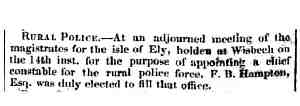
He was working as Chief Constable of the Rural Police Force in Isle of Ely, Cambridgeshire, England on Jul 14, 1841 14 He was appointed to the position at a meeting of the Isle of Ely magistrates at Wisbech
[REF: Cambridge Chronicle and Journal, 24 July 1841 Page 3, Col 4
http://www.britishnewspaperarchive.co.uk/search/results/1841-07-24?NewspaperTitle=Cambridge%2BChronicle%2Band%2BJournal&Issue Id=BL%2F0000420%2F18410724%2F&County=Cambridgeshire%2C%20England
Accessed October 23, 2016]
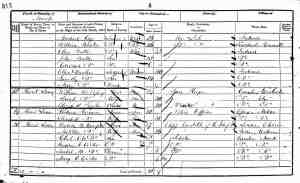
He was residing at No 20 Hurst Lane, March in Isle of Ely, Cambridgeshire, England on Mar 30, 1851 14 He is listed in the Census with his wife Matilda, sons Robert & Frederic, daughters Isabel & Mary, as well as staff members.
He was employed as a Recruiting Officer for the Sydney Police in 1854 in England. In 1853 in the Colony of New South Wales policing was being carried out by former military personnel and other untrained people. The government of the day determined it would be better to have trained, experienced people doing tis job. Accordingly it was decided to recruit from Great Britain. The Police Recruiting Act 1853 authorised Mr. Edward Barnard - Colonial Agent General for the New South Wales Colony in London to organise the recruitment.
[REF: Police Recruiting Act 1853 No. 30a - (October 24, 1853)
http://www.austlii.edu.au/au/legis/nsw/num_act/pra1853n30216
Accessed October 23, 2016]
Mr. Barnard engaged, among others, Frederick B. Hampton, then Chief Constable of Isle of Ely to carryout this task on behalf of the Colony. Hampton was offered free relocation for him and his family to Sydney with the position of Inspector, Sydney Police Force.
There is a story 15 extracted from page 89 of "Reminiscences of a Colonial Judge" [written in 1890 by James Sheen Dowling, Pulished by Federation Press, May 1996]
"To Sir Charles Cowper the credit is due for having suggested the importation of trained policemen from England. The idea was excellent, and the result was most successful. It is immaterial to enquire who selected them. They came in two detachments, the first in the ship Bangalore which arrived on the 13th January 1855 and brought 46 chosen from the London police, officered by Inspectors John Francis Weale and William John Brown. Of all who came in that vessel only three are now in the force, viz Superintendents George Read, George Ryland and Charles Saunderson. The ship Exodus brought a further number on the 26th July 1855, consisting of 72 men chosen from the various provincial towns of England. The officers were Sir John Cecil Read; late Governor of Darlinghurst Gaol, now on pension, and Mr James Black and Captain FB Hampton, both deceased."
Conditions were brutal for the immigrants; this article appeared in the Empire newspaper Thursday March 22, 1855. The writer arrived on the Bangalore in January 1855.
THE NEW POLICE.
To the Editor of the Empire.
Sir, I beg, most respectfully, a corner in your valuable paper, as the only means I have of making known to the public the treatment which we (the police per Bangalore) have received since our arrival in this colony.
However unpopular the police may be in Sydney, I think the majority of your readers will agree that it was an unjust, as well as a mean proceeding, to lure a number of men from England, causing them to break up their homes, and give up several years' service, under the inducement of apparently high wages, when contrasted with our pay at home, but which, on our arrival here, we find is far below the ordinary pay in the colony, and will not enable us to maintain ourselves as respectable as we could in England.
We were promised that lodgings should be provided for us; they have found us tents, which has caused much sickness amongst us. Already we have lost four children, and there are now two men in the infirmary with rheumatic fever. There is scarcely a tent but some of the family are under medical treatment. The doctor attached to the police force has, from the first, declared the tents unfit for dwellings, and at last two medical men have been appointed to examine the state of the tents, and report upon the health of parties living in them; the consequence, I believe, is that the tents are condemned as unfit for us to live in. Still we are kept in them, whilst sickness is increasing throughout the camp. We are receiving 6s. per day, subject to 1s. per day stoppage for sickness. I will leave it to your readers to judge if we can be expected to perform the duties, required of us if we do not receive different treatment, during our three years' engagement, from those in authority over us.
Sydney, March 20. Sailing Ship "BANGALORE"
[REF: THE NEW POLICE. (1855, March 22). Empire (Sydney, NSW : 1850 - 1875), p. 4. Retrieved October 30, 2016, from http://nla.gov.au/nla.news-article60178973]
The following article appeared in the Adelaide Times, July 13, 1855
"One sergeant and twenty men of the Manchester police force have been selected by the Government to proceed to Sydney. Captain Hampton, who is acting on behalf of the Government in organising the Australian drafts, has selected a number of men from the Liverpool police force. The men are to be paid 5s. per day; sergeants to receive 6s. 3d. and superintendents 8s. 6d. By agreement they are to remain in the police force at Sydney for three years."
[REF: MISCELLANEOUS. (1855, July 13). Adelaide Times (SA : 1848 - 1858), p. 3. Col 4. Retrieved October 27, 2016, from http://nla.gov.au/nla.news-article207071506]
Frederic left London on April 21 and arrived in Sydney on July 27, 1855 aboard "Exodus". With him were his wife Matilda, son [Frederick] Osborn 12, daughters Isobel 9, Catherine 3, and Sophia infant. Their oldest son Robert 14 arrived the following year aboard "Prince Alfred". Frederick's age was noted as 40 and his occupation as "Inspector of Police".
[REF: Source Citation: State Records Authority of New South Wales; Kingswood New South Wales, Australia; Persons on bounty ships to Sydney, Newcastle, and Moreton Bay. (Board's Immigrant Lists); Series: 5317; Reel: 2469; ; Item: [4/4948]. Retrieved October 30, 2016]
For the trial of one Neil Buchanan for desertion from the Sydney Police Force Feb 10, 1856 Frederick Black [sic] Hampton, Inspector of the Sydney Police, was called to give evidence regarding Buchanan's engagement in England.
Hampton, in consideration for free passage under the Local Act, engaged 100 policemen in England to serve as ordinary constables at the rate of 5 shillings per day.
He engaged men about a month before sailing, boarding them aboard "Exodus" in the Mersey River, Liverpool, England.
[REF: Court proceedings in Sydney Morning Herald (NSW : 1842 - 1954), Monday 11 February 1856, page 3 - Trove: http://nla.gov.au/nla.news-article12979210 Accessed Oct 23, 2016]
He was a member of The Grand Lodge of Freemasons of Ireland - Lodge No. 260 On Oct 31, 1856 in Sydney, New South Wales, Australia. 16 It is noted in the register that he resigned in 1857.
In May of 1857 Frederic was transferred to the New South Wales Native Police, Northern Division, based in Brisbane. On his departure from Sydney's 'D' Division a sliver snuff box was presented to him inscribed:
"Capt Frederick Blagg Hampton K.I.C.
late of the British Auxiliary Legion
and now Inspector in Charge of Division "D" of
the Metropolitan Police Force of New South Wales.
As a mark of esteem from a few of his friends in his district
Sydney 1st May 1857."
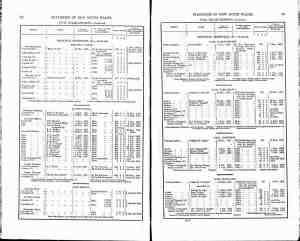
His New Position
Frederic had a new position as Secretary for the New South Wales Native Police Force on May 18, 1857 in Brisbane, Queensland, Australia. Appointed to the position by the Governor on a salary of £200 0s 0p p.a. plus 2s. 6p. per diem in lieu of provisions.
[REF: Returns of the Colony, "Blue Books" 1822-57. Kingswood, New South Wales, Australia: State Records Authority of New South Wales. Series 1286, 176 rolls.]
[Originally the New South Wales Northern District Native Police]
Australian native police units, consisting of Aboriginal troopers under the command usually of a single white officer, existed in several Australian colonies during the nineteenth century. From 1848 the NSW Native Police were deployed in the northern districts of New South Wales, nearly exclusively within the borders of the later colony of Queensland.
Before the separation of Queensland from New South Wales in 1859, the border police and, subsequently, the NSW Native Police were the main government instrument of Aboriginal administration. After separation, the administration of Indigenous matters was transferred to the Colonial Secretary for Queensland. In 1864, the Native Police were brought under the control of the newly appointed Commissioner of Police. In 1865 the force was renamed the Native Mounted Police and the force continued to operate as a separate police unit until its disbandment in 1900.
The Queensland Native Police was a large and notorious force, used to reduce aboriginal attacks and resistance against squatters. Members were recruited from southern tribes and were foreign to the local tribes, regarding other blacks as their enemies.
It was arguably also the most controversial. Its mode of operation cannot by any standard be classified as "law enforcement". At least from the period 1857 onward to 1890s there are no signs that this force was engaged in anything but general punitive expeditions, commonly performed as deadly daybreak attacks on Aboriginal camps. All signs are that the force generally took no prisoners at the frontier and in the few cases on record when this did happen these prisoners were on record as having been shot during attempts to escape."
[REF: Extract in part from Wikipedia " Australian native police"
https://en.wikipedia.org/wiki/Australian_native_police - accessed Oct 28, 2016]
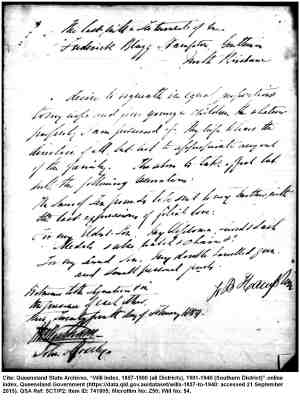
Frederic signed a will two days before he died at the Colonial Secretary's house on Feb 24, 1859 in Brisbane, Queensland, Australia. 17 It is notable that his will was witnessed by John Clements Wickham after whom Wickham Terrace in Brisbane was named. From the handwriting it appears that John Wickham wrote the will and then Frederic signed in a very shaky hand. It is obvious that Frederic was very sick.
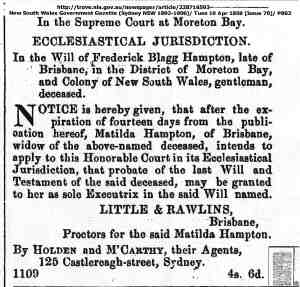
Frederic B Hampton's will granted probate in the Supreme Court at Moreton Bay to Matilda on Tuesday April 19, 1859.
[REF: ECCLESIASTICAL JURISDICTION. (1859, April 19). New South Wales Government Gazette (Sydney : 1832 - 1900), p. 882. Retrieved October 23, 2016, from http://nla.gov.au/nla.news-article228716593]

Frederic married Matilda Stratfold, daughter of Robert Collet Stratfold and Mary Millard, on Oct 25, 1841 in Woburn, Bedfordshire, England.1 2 3 4 (Matilda Stratfold was born on Nov 17, 1824 in Woburn, Bedfordshire, England 18 19 20, baptised on Dec 14, 1824 in Woburn, Bedfordshire, England,19 died on Aug 14, 1892 in South Brisbane, Queensland, Australia 21 and was buried on Aug 16, 1892 in Toowong, Queensland, Australia.)
|





 Cause of his death was Bowel obstruction.
Cause of his death was Bowel obstruction.